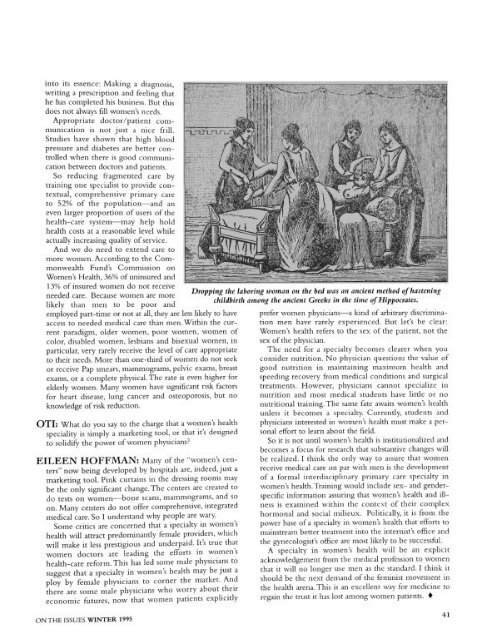view entire issue in pdf format - On The Issues Magazine
view entire issue in pdf format - On The Issues Magazine
view entire issue in pdf format - On The Issues Magazine
Create successful ePaper yourself
Turn your PDF publications into a flip-book with our unique Google optimized e-Paper software.
<strong>in</strong>to its essence: Mak<strong>in</strong>g a diagnosis,<br />
writ<strong>in</strong>g a prescription and feel<strong>in</strong>g that<br />
he has completed his bus<strong>in</strong>ess. But this<br />
does not always fill women's needs.<br />
Appropriate doctor/patient communication<br />
is not just a nice frill.<br />
Studies have shown that high blood<br />
pressure and diabetes are better controlled<br />
when there is good communication<br />
between doctors and patients.<br />
So reduc<strong>in</strong>g fragmented care by<br />
tra<strong>in</strong><strong>in</strong>g one specialist to provide contextual,<br />
comprehensive primary care<br />
to 52% of the population—and an<br />
even larger proportion of users of the<br />
health-care system—may help hold<br />
health costs at a reasonable level while<br />
actually <strong>in</strong>creas<strong>in</strong>g quality of service.<br />
And we do need to extend care to<br />
more women. Accord<strong>in</strong>g to the Commonwealth<br />
Fund's Commission on<br />
Women's Health, 36% of un<strong>in</strong>sured and<br />
13% of <strong>in</strong>sured women do not receive<br />
needed care. Because women are more<br />
likely than men to be poor and<br />
employed part-time or not at all, they are less likely to have<br />
access to needed medical care than men. With<strong>in</strong> the current<br />
paradigm, older women, poor women, women of<br />
color, disabled women, lesbians and bisexual women, <strong>in</strong><br />
particular, very rarely receive the level of care appropriate<br />
to their needs. More than one-third of women do not seek<br />
or receive Pap smears, mammograms, pelvic exams, breast<br />
exams, or a complete physical. <strong>The</strong> rate is even higher for<br />
elderly women. Many women have significant risk factors<br />
for heart disease, lung cancer and osteoporosis, but no<br />
knowledge of risk reduction.<br />
OTI: What do you say to the charge that a women's health<br />
speciality is simply a market<strong>in</strong>g tool, or that it's designed<br />
to solidify the power of women physicians<br />
EILEEN HOFFMAN: Many of the "women's centers"<br />
now be<strong>in</strong>g developed by hospitals are, <strong>in</strong>deed, just a<br />
market<strong>in</strong>g tool. P<strong>in</strong>k curta<strong>in</strong>s <strong>in</strong> the dress<strong>in</strong>g rooms may<br />
be the only significant change. <strong>The</strong> centers are created to<br />
do tests on women—bone scans, mammograms, and so<br />
on. Many centers do not offer comprehensive, <strong>in</strong>tegrated<br />
medical care. So I understand why people are wary.<br />
Some critics are concerned that a specialty <strong>in</strong> women's<br />
health will attract predom<strong>in</strong>antly female providers, which<br />
will make it less prestigious and underpaid. It's true that<br />
women doctors are lead<strong>in</strong>g the efforts <strong>in</strong> women's<br />
health-care reform. This has led some male physicians to<br />
suggest that a specialty <strong>in</strong> women's health may be just a<br />
ploy by female physicians to corner the market. And<br />
there are some male physicians who worry about their<br />
economic futures, now that women patients explicitly<br />
Dropp<strong>in</strong>g the labor<strong>in</strong>g woman on the bed was an ancient method of hasten<strong>in</strong>g<br />
childbirth among the ancient Greeks <strong>in</strong> the time of Hippocrates.<br />
prefer women physicians—a k<strong>in</strong>d of arbitrary discrim<strong>in</strong>ation<br />
men have rarely experienced. But let's be clear:<br />
Women's health refers to the sex of the patient, not the<br />
sex of the physician.<br />
<strong>The</strong> need for a specialty becomes clearer when you<br />
consider nutrition. No physician questions the value of<br />
good nutrition <strong>in</strong> ma<strong>in</strong>ta<strong>in</strong><strong>in</strong>g maximum health and<br />
speed<strong>in</strong>g recovery from medical conditions and surgical<br />
treatments. However, physicians cannot specialize <strong>in</strong><br />
nutrition and most medical students have little or no<br />
nutritional tra<strong>in</strong><strong>in</strong>g. <strong>The</strong> same fate awaits women's health<br />
unless it becomes a specialty. Currently, students and<br />
physicians <strong>in</strong>terested <strong>in</strong> women's health must make a personal<br />
effort to learn about the field.<br />
So it is not until women's health is <strong>in</strong>stitutionalized and<br />
becomes a focus for research that substantive changes will<br />
be realized. I th<strong>in</strong>k the only way to assure that women<br />
receive medical care on par with men is the development<br />
of a formal <strong>in</strong>terdiscipl<strong>in</strong>ary primary care specialty <strong>in</strong><br />
women's health. Tra<strong>in</strong><strong>in</strong>g would <strong>in</strong>clude sex- and genderspecific<br />
<strong>in</strong><strong>format</strong>ion assur<strong>in</strong>g that women's health and illness<br />
is exam<strong>in</strong>ed with<strong>in</strong> the context of their complex<br />
hormonal and social milieux. Politically, it is from the<br />
power base of a specialty <strong>in</strong> women's health that efforts to<br />
ma<strong>in</strong>stream better treatment <strong>in</strong>to the <strong>in</strong>ternist's office and<br />
the gynecologist's office are most likely to be successful.<br />
A specialty <strong>in</strong> women's health will be an explicit<br />
acknowledgement from the medical profession to women<br />
that it will no longer use men as the standard. I th<strong>in</strong>k it<br />
should be the next demand of the fem<strong>in</strong>ist movement <strong>in</strong><br />
the health arena. This is an excellent way for medic<strong>in</strong>e to<br />
rega<strong>in</strong> the trust it has lost among women patients. •<br />
ON THE ISSUES WINTER 1995<br />
11

















